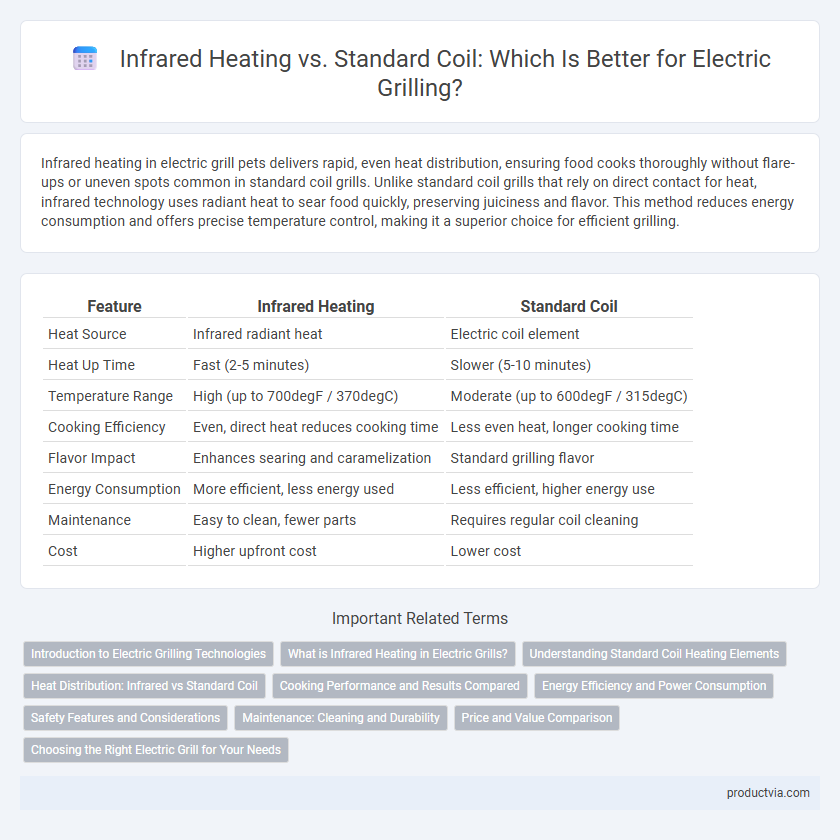Infrared heating in electric grill pets delivers rapid, even heat distribution, ensuring food cooks thoroughly without flare-ups or uneven spots common in standard coil grills. Unlike standard coil grills that rely on direct contact for heat, infrared technology uses radiant heat to sear food quickly, preserving juiciness and flavor. This method reduces energy consumption and offers precise temperature control, making it a superior choice for efficient grilling.
Table of Comparison
| Feature | Infrared Heating | Standard Coil |
|---|---|---|
| Heat Source | Infrared radiant heat | Electric coil element |
| Heat Up Time | Fast (2-5 minutes) | Slower (5-10 minutes) |
| Temperature Range | High (up to 700degF / 370degC) | Moderate (up to 600degF / 315degC) |
| Cooking Efficiency | Even, direct heat reduces cooking time | Less even heat, longer cooking time |
| Flavor Impact | Enhances searing and caramelization | Standard grilling flavor |
| Energy Consumption | More efficient, less energy used | Less efficient, higher energy use |
| Maintenance | Easy to clean, fewer parts | Requires regular coil cleaning |
| Cost | Higher upfront cost | Lower cost |
Introduction to Electric Grilling Technologies
Infrared heating in electric grills uses electromagnetic waves to directly heat food, providing faster cooking times and more even heat distribution compared to traditional standard coil elements. Standard coil grills rely on resistive heating elements that warm the air around the food, often resulting in slower heat transfer and less precise temperature control. Infrared technology minimizes flare-ups and enhances flavor retention by evenly penetrating food surfaces, making it a preferred choice for efficient and consistent grilling.
What is Infrared Heating in Electric Grills?
Infrared heating in electric grills uses ceramic or metal plates heated by electric elements to emit infrared radiation that cooks food evenly by directly heating the surface. This method produces higher temperatures faster than standard coil heating, resulting in better searing and reduced cooking times. Infrared grills also provide consistent heat distribution, minimizing flare-ups and preserving juiciness in grilled food.
Understanding Standard Coil Heating Elements
Standard coil heating elements in electric grills use resistance wires that generate heat when electricity passes through, creating an even and consistent cooking surface. These coils typically reach temperatures between 400degF and 600degF, ideal for traditional grilling tasks and achieving a seared exterior. Their design allows for gradual heating and efficient heat distribution, making them a reliable and affordable option for everyday use.
Heat Distribution: Infrared vs Standard Coil
Infrared heating delivers intense, even heat by directly warming the food's surface, creating faster searing and consistent cooking results. Standard coil grills rely on convection, distributing heat less uniformly and often causing hot spots that can lead to uneven grilling. Infrared systems achieve superior heat distribution, enhancing texture and flavor, while standard coils may require more careful monitoring to avoid uneven cooking.
Cooking Performance and Results Compared
Infrared heating delivers rapid, even heat that sears food thoroughly, preserving moisture and enhancing flavor compared to standard coil grills which often produce uneven heat zones and longer cooking times. Infrared grills reach higher temperatures faster, enabling superior caramelization and grill marks vital for optimal texture and taste. Standard coil grills may struggle with temperature consistency, leading to less precise cooking results and potential flavor loss.
Energy Efficiency and Power Consumption
Infrared heating in electric grills offers higher energy efficiency by directly transferring heat to food through infrared radiation, reducing heat loss and shortening cooking times. Standard coil grills consume more power due to slower heat transfer and longer preheating periods, resulting in increased energy usage. Infrared grills typically use 20-30% less electricity compared to coil heaters while maintaining consistent high temperatures for optimal grilling.
Safety Features and Considerations
Infrared heating in electric grills provides faster, more even heat distribution while reducing flare-ups due to its sealed design, enhancing overall cooking safety. Standard coil grills operate at lower temperatures with exposed heating elements, which can increase the risk of accidental burns and grease fires. Infrared grills often include advanced safety features such as automatic shutoff and cooler exterior surfaces, making them a safer choice for indoor and outdoor use.
Maintenance: Cleaning and Durability
Infrared electric grills feature smooth ceramic or quartz heating elements that resist food buildup and are easier to clean compared to standard coil grills, which have exposed metal coils prone to grease accumulation and difficult scrubbing. Infrared elements typically have longer lifespans due to their durable construction and efficient heat transfer, while coil heaters may degrade faster under repeated heating cycles and exposure to moisture. Choosing infrared grilling technology reduces maintenance effort and extends the grill's overall durability, making it a practical option for frequent use.
Price and Value Comparison
Infrared electric grills typically have a higher upfront cost compared to standard coil models due to advanced heating technology that offers faster and more even cooking. Standard coil grills are more affordable and widely available but may provide less consistent heat distribution, impacting cooking quality. Evaluating long-term value, infrared grills often justify their premium price through energy efficiency and superior grilling results, making them a worthy investment for frequent users.
Choosing the Right Electric Grill for Your Needs
Infrared heating grills deliver faster, more even heat distribution by using radiant heat, which sears food quickly and locks in moisture, making them ideal for precise temperature control and juicier results. Standard coil electric grills rely on convection heat, offering consistent warmth suitable for slow cooking and versatility in grilling styles. Selecting the right electric grill depends on your cooking preferences, with infrared models best for quick searing and enhanced flavor, while coil grills provide dependable performance for a range of recipes.
Infrared heating vs standard coil for grilling Infographic

 productvia.com
productvia.com